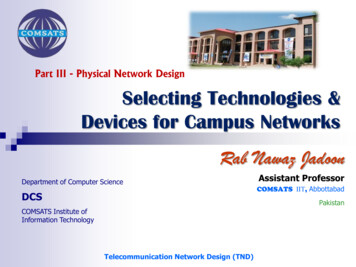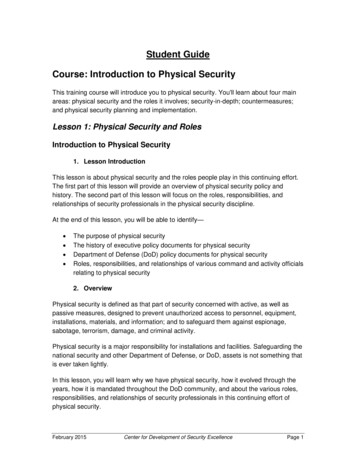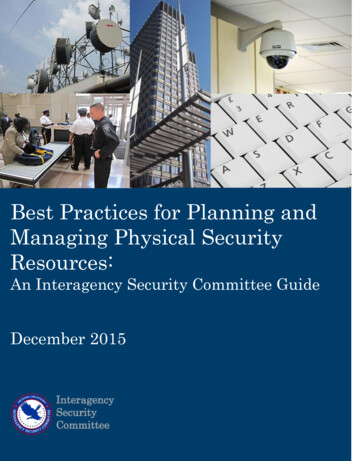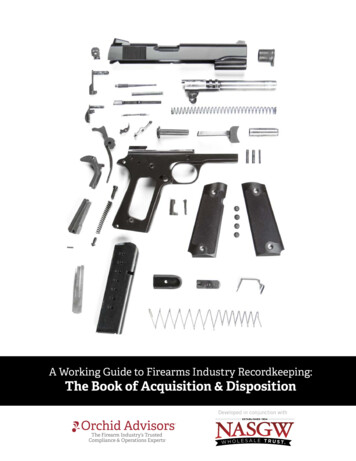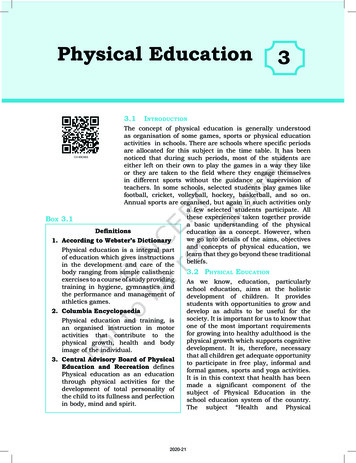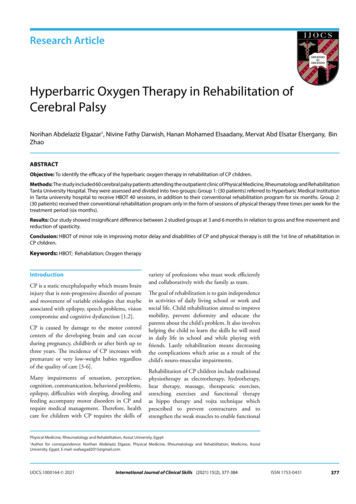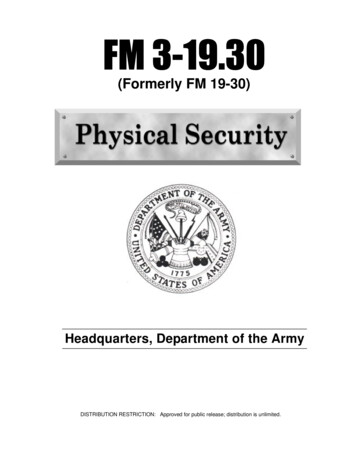
Transcription
ÿþýüûúùøü (Formerly FM 19-30)Headquarters, Department of the ArmyDISTRIBUTION RESTRICTION: Approved for public release; distribution is unlimited.
*FM 3-19.30HeadquartersDepartment of the ArmyWashington, DC, 8 January 2001Field ManualNo. 3-19.30PHYSICAL SECURITYContentsPagePREFACE. viChapter 1PHYSICAL-SECURITY CHALLENGES .1-1Overview.1-1Automated Information Systems. 1-1OPSEC and the Threat . 1-3Chapter 2THE SYSTEMS APPROACH. 2-1Protective Systems . 2-1Systems Development. 2-2The Integrated Protective System .2-5Security Threats. 2-6Chapter 3DESIGN APPROACH . 3-1Design Strategies . 3-1Protective Measures . 3-1Vehicle Bombs.3-2Exterior Attack . 3-10Standoff Weapons . 3-13Ballistics. 3-16Forced Entry .3-17Covert Entry and Insider Compromise.3-19Surveillance and Eavesdropping .3-20Mail and Supply Bombs .3-22Chemical and Biological Contamination .3-24Chapter 4PROTECTIVE BARRIERS . 4-1Overview.4-1Fencing . 4-2Utility Openings. 4-5Other Perimeter Barriers. 4-5Security Towers .4-5Installation Entrances .4-6Warning Signs .4-8Other Signs.4-8Installation Perimeter Roads and Clear Zones .4-8Arms-Facility Structural Standards .4-9Distribution Restriction: Approved for public release; distribution is unlimited.*This publication supersedes FM 19-30, 1 March 1979.i
FM 3-19.30PageChapter 5PHYSICAL-SECURITY LIGHTING . 5-1Overview . 5-1Commander’s Responsibility. 5-1Planning Considerations . 5-2Principles of Security Lighting . 5-3Types of Lighting. 5-4Wiring Systems . 5-5Maintenance. 5-6Chapter 6ELECTRONIC SECURITY SYSTEMS . 6-1Overview . 6-1ESS Design Considerations . 6-2Interior ESS Considerations . 6-7Exterior ESS Considerations. 6-8ESS Alarm-Annunciation System. 6-12ESS Software. 6-17Interior Intrusion-Detection Sensors. 6-18Exterior Intrusion-Detection Sensors . 6-29Electronic Entry Control . 6-39Application Guidelines. 6-42Performance Criteria . 6-43Data Transmission . 6-44CCTV for Alarm Assessment and Surveillance. 6-45Chapter 7ACCESS CONTROL . 7-1Designated Restricted Areas . 7-1Employee Screening . 7-4Identification System . 7-4Duress Code . 7-10Access-Control Rosters . 7-10Methods of Control. 7-10Security Controls of Packages, Personal Property, and Vehicles. 7-11Tactical-Environment Considerations . 7-12Chapter 8LOCK AND KEY SYSTEMS. 8-1Installation and Maintenance . 8-1Types of Locking Devices . 8-1Chapter 9SECURITY FORCES . 9-1Types of Security Forces . 9-1Authority and Jurisdiction . 9-2Personnel Selection . 9-3Security Clearance. 9-3Organization and Employment of Forces . 9-4Headquarters and Shelters . 9-4Execution of Security Activities . 9-5Training Requirements. 9-6Supervision . 9-7Uniforms. 9-8Vehicles. 9-9Firearms . 9-9ii
FM 3-19.30PageCommunications . 9-9Miscellaneous Equipment . 9-9Military Working Dogs . 9-10Summary . 9-10Chapter 10IN-TRANSIT SECURITY. 10-1In-Port Cargo. 10-1Rail Cargo . 10-4Pipeline Cargo. 10-6Convoy Movement . 10-7Chapter 11INSPECTIONS AND SURVEYS . 11-1Inspections . 11-1Surveys . 11-2Appendix AMETRIC CONVERSION CHART . A-1Appendix BSAMPLE INSTALLATION CRIME-PREVENTION HANDBOOK. B-1Section I — Installation Crime-Prevention Programs .B-1Crime-Prevention Working Groups . B-1Crime-Prevention Officers . B-2Crime-Prevention Program Development .B-2Training .B-5Civilian Crime-Prevention Organizations.B-5Section II — Criminal Analysis .B-5Sources of Information .B-6Individual Criminal Analysis . B-9Criminal-Analysis Procedures . B-15Criminal-Analysis Summary . B-17Section III — Command and Law-Enforcement Countermeasures . B-17Crime Hot Lines . B-17Crime Prevention Through Environmental Design . B-18Specialized Patrol Tactics and Surveillance .B-25Publicity Campaigns.B-30Residential-Security Surveys .B-31Juvenile Crime Prevention .B-34Fraud .B-47Internal Theft .B-52Pilferage .B-53Section IV — Army Property at the Local Level .B-61Motor Vehicles .B-61Consumer Outlets .B-63Arson .B-66Section V — Community Crime-Prevention Programs.B-67Neighborhood Watch Program.B-67Operation ID .B-71Neighborhood Walks .B-74Vigilantism .B-75Mobile Patrols .B-76Project Lock .B-76Section VI — Evaluation .B-79iii
FM 3-19.30PageCrime-Prevention Programs.B-79Crime Rates .B-83Measures of Effectiveness .B-84Internal Measures .B-85Appendix CINTELLIGENCE, COUNTERINTELLIGENCE, AND THREAT ANALYSIS .C-1Information Sources .C-1Responsibilities of US Government Lead Agencies.C-2Information Requirements.C-4Threat Analysis and Assessment.C-5Determination of the Threat Level.C-6Appendix DCRISIS-MANAGEMENT PLAN .D-1Appendix EOFFICE SECURITY MEASURES .E-1Physical-Security Survey .E-1Security-Engineering Assessment .E-1Technical Assessment of Responses .E-2Physical-Security Enhancement Measures.E-2Appendix FPHYSICAL-SECURITY PLAN. F-1Annexes . F-6Tactical-Environment Considerations . F-7Appendix GPERSONAL-PROTECTION MEASURES . G-1Personal Protection. G-1Working Environment. G-2Home Environment . G-4Appendix HBOMBS.H-1General .H-1Concealing Bombs .H-1Damage and Casualty Mechanisms .H-1Telephonic Threats .H-3Evacuation Drills .H-3Searching for a Suspected IED.H-6Appendix IEXECUTIVE PROTECTION . I-1Supplemental Security Measures . I-1Executive Protection Goals . I-1Residential Security Measures. I-2Transportation Measures . I-4Individual Protective Measures . I-7Combating-Terrorism Training for Executives. I-10Travel to Potential Physical-Threat Risk Areas . I-10Protective Security Details . I-10Executive-Protection System Integration . I-12Appendix JRESOURCE MANAGEMENT. J-1Funding Programs. J-1iv
FM 3-19.30PageProjected Requirements. J-1Obligation Plan . J-1Types of Appropriations . J-2Appendix KVULNERABILITY ASSESSMENT.K-1Assessment Considerations.K-1THREATCON Levels .K-2Assessing Vulnerability .K-3GLOSSARY . Glossary-1BIBLIOGRAPHY. Bibliography-1INDEX . Index-1v
PrefaceThis field manual (FM) sets forth guidance for all personnel responsible for physical security. It isthe basic reference for training security personnel. It is intended to be a “one-stop” physicalsecurity source for the Department of Defense (DOD), the Department of the Army (DA), andother proponents and agencies of physical security.Prevention and protection are the two primary concerns of physical security. Both serve thesecurity interests of people, equipment, and property. These interests must be supported at allstaff and command levels; and this support must be unified in joint, multinational, andinteragency operations.Support to joint, multinational, and interagency operations relies on the fact that the Army willnot conduct operations alone. Additionally, force-projection operations conducted by the militarywill involve the integration of war-fighting capabilities with stability and support operations.This manual’s primary focus is the articulation of a balanced understanding of physical securityfor joint, multinational, and interagency operations throughout the environments of peacetime,conflict, and war (whether in the continental United States [CONUS] or outside the continentalUnited States [OCONUS]).Physical security must integrate the various capabilities of joint, multinational, and interagencyoperations in pursuit of a seamless connection between the strategic, operational, and tacticallevels of war. Physical security must also address an expanded range of threats that embraces notonly traditional threat components of war, but also nontraditional threats generated byguerrillas, terrorists, criminals, and natural or man-made disasters. In addition, physicalsecurity must address the concept of Homeland Defense due to the aforementioned threats.Homeland Defense is the military’s role in the United States (US) government’s principal task ofprotecting its territory and citizens. This is accomplished by joint, interagency, andmultijurisdictional organizations. Homeland Defense includes— Supporting domestic authorities for crisis and consequence management with regardto weapons of mass destruction (WMD).Protecting national-security assets (such as installations) and deploying forces andensuring the availability, integrity, and adequacy of other critical assets.Deterring and defending against strategic attacks while maintaining freedom ofaction through antiterrorism and force-protection operations.With this in mind, it is essential to address the five pillars of force protection—combatingterrorism, physical security, personal security, law enforcement, and operations security(OPSEC). Physical security is a central component of force protection and provides an integratedvenue to express support for operations. Physical security is a primary-leader task and aninherent part of all operations to protect soldiers, family members, civilians, and resources. Thisfunction directly supports the Army’s universal task list.While the effects of these changes (when viewed individually) appear revolutionary, the basicactivities remain relatively unchanged, though executed under different conditions andstandards. Another component that remains unchanged is our reliance upon quality soldiers andleaders well versed in physical-security fundamentals. Leaders will be challenged to ensure thatthey are functionally proficient; possess an understanding of physical-security operations; arevi
FM 3-19.30educated in joint, multinational, and interagency operations; and have the ability to performphysical-security functions in support of full-dimension operations.Appendix A contains an English-to-metric measurement conversion chart. Appendix B is asample installation crime-prevention handbook. This handbook is designed to assist commandersin developing crime-prevention programs for their installation and units.The proponent of this publication is HQ TRADOC. Send comments and recommendations on DAForm 2028 directly to Commandant, US Army Military Police School (USAMPS), ATTN: ATSJMP-TD, Directorate of Training, 401 Engineer Loop, Suite 2060, Fort Leonard Wood, Missouri65473-8926.Unless this publication states otherwise, masculine nouns and pronouns do not refer exclusivelyto men.vii
Chapter 1Physical-Security ChallengesPhysical security is defined as that part of security concerned withphysical m easures designed to safeguard personnel; to preventunauthorized access to equipment, installations, material, and documents;and to safeguard against espionage, sabotage, damage, and theft. As such,all military operations face new and complex physical-security challengesacross the full spectrum of operations. Challenges relative to physicalsecurity include the control of populations, information dominance,multinational and interagency connectivity, antiterrorism, and the use ofphysical-security assets as a versatile force multiplier.OVERVIEW1-1. Reductions in manpower and funding are critical challenges to physicalsecurity. Manpower for supporting physical-security activities is reducedthrough deployments and cutbacks. The rapid evolution of physical-securityequipment technology also lends to physical-security challenges, which areexponentially multiplied by the introduction of the information age.1-2. Physical-security challenges must be understood, and measures must betaken to minimize them to enhance force protection. Leaders must createorder when coming upon a situation; and when they depart, some semblanceof that order must remain. They must be aware of the human-dimensionfactors and ensure that their soldiers do not become complacent. It washuman error rather than modern technology that took lives in the bombings ofthe African embassy. Warning was given, but not heeded. Complacencybecame a physical-security challenge.AUTOMATED INFORMATION SYSTEMS1-3. Success on past battlefields has resulted not so much from technologicaladvances, but from innovative ways of considering and combining availableand new technologies as they apply to war fighting. Some of these technologiesdealt with disseminating and processing information. For example, thetelegraph, the telephone, the radio, and now the computer have redefined thefire-support paradigm.1-4. As the armed forces move into the technological age, a greater need forphysical-security measures is required. The risks associated with automatedinformation systems (AISs) are widespread because computers are used foreverything. Army Regulation (AR) 380-19 outlines the requirements thatcommanders and managers need for processing unclassified and classifiedinformation and for securing media, software, hardware, and differentsystems.Physical-Security Challenges 1-1
FM 3-19.301-5. The threat to AISs and information systems security (ISS) involvesdeliberate, overt, and covert acts. This includes the physical threat to tangibleproperty, such as the theft or destruction of computer hardware. Also includedis the threat of electronic, electromagnetic-pulse, radio-frequency (RF), orcomputer-based attacks on the information or communications componentsthat control or make up critical Army command and control (C2)infrastructures. In most cases, the threat’s target is the information itselfrather than the system that transmits it. The threat comes from a range ofsources, including the following: Unauthorized users (such as hackers) are the main source of today’sattacks, primarily against computer-based systems. The threat theypose to AIS networks and mainframe computers is growing. Insiders are those individuals with legitimate access to an AIS. Theypose the most difficult threat to defend against. Whether recruited orself-motivated, the AIS insider has access to systems normallyprotected by ISS against an attack. Terrorists once had to operate in the immediate vicinity of a target togain access to or collect intelligence on that target. The proximity tothe target risked exposure and detection. Today, a terrorist canaccomplish most target selection, intelligence collection, andpreoperational planning by gaining access through a computernetwork. He can increase his probability of success by using computersystems to reduce his “time on target.” Terrorist access to an AIS alsoincreases the threat of critical-data destruction or manipulation.Although his presence would be virtual, the potential for damage toArmy C2 systems could be equal to or greater than that achieved byphysical intrusion, especially when used as a force multiplier inconjunction with a traditional terrorist attack. Therefore, wh
leaders well versed in physical-security fundamentals. Leaders will be challenged to ensure that they are functionally proficient; possess an understanding of physical-security operations; are. vii FM 3-19.30 educated in joint,


